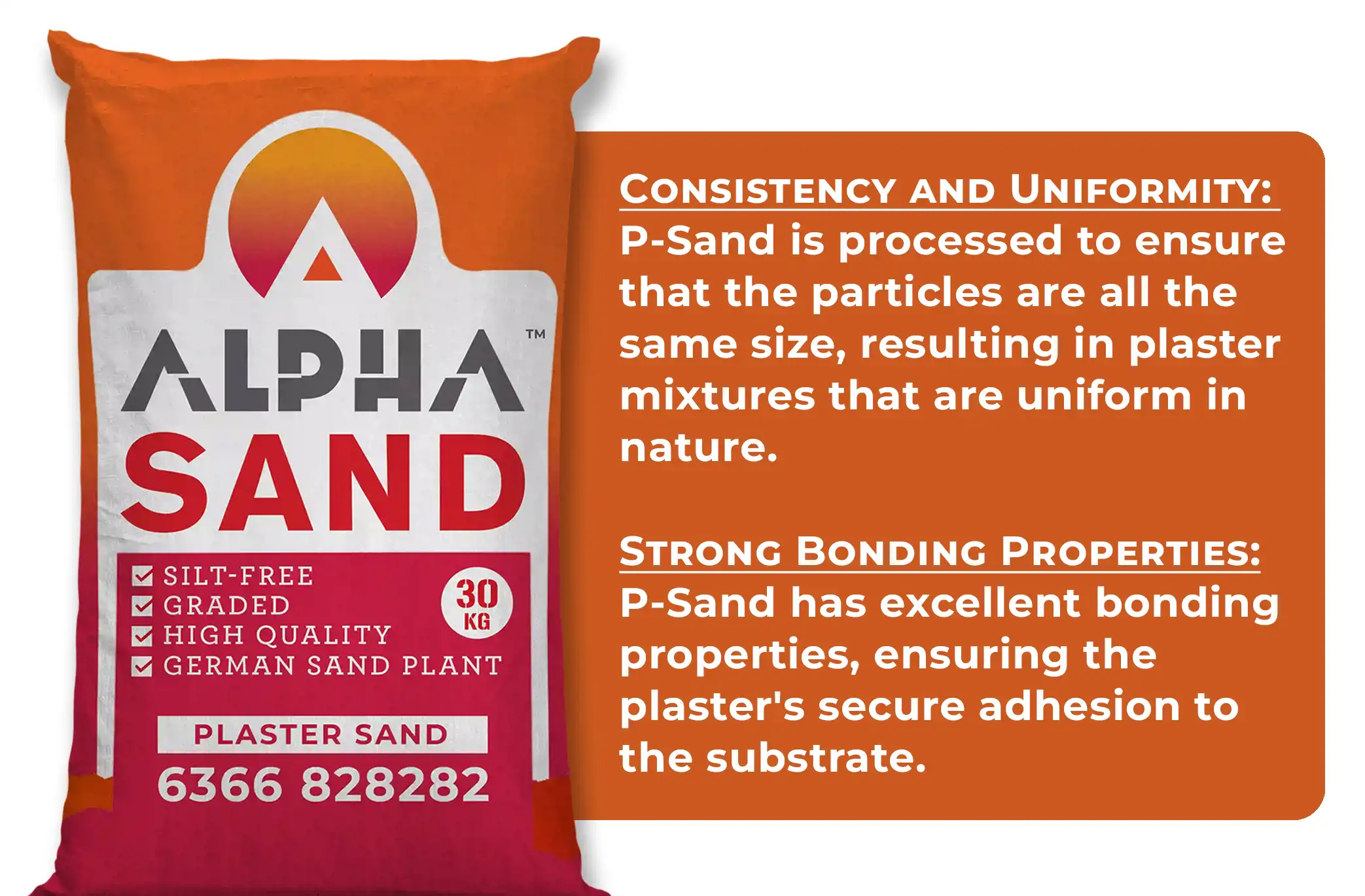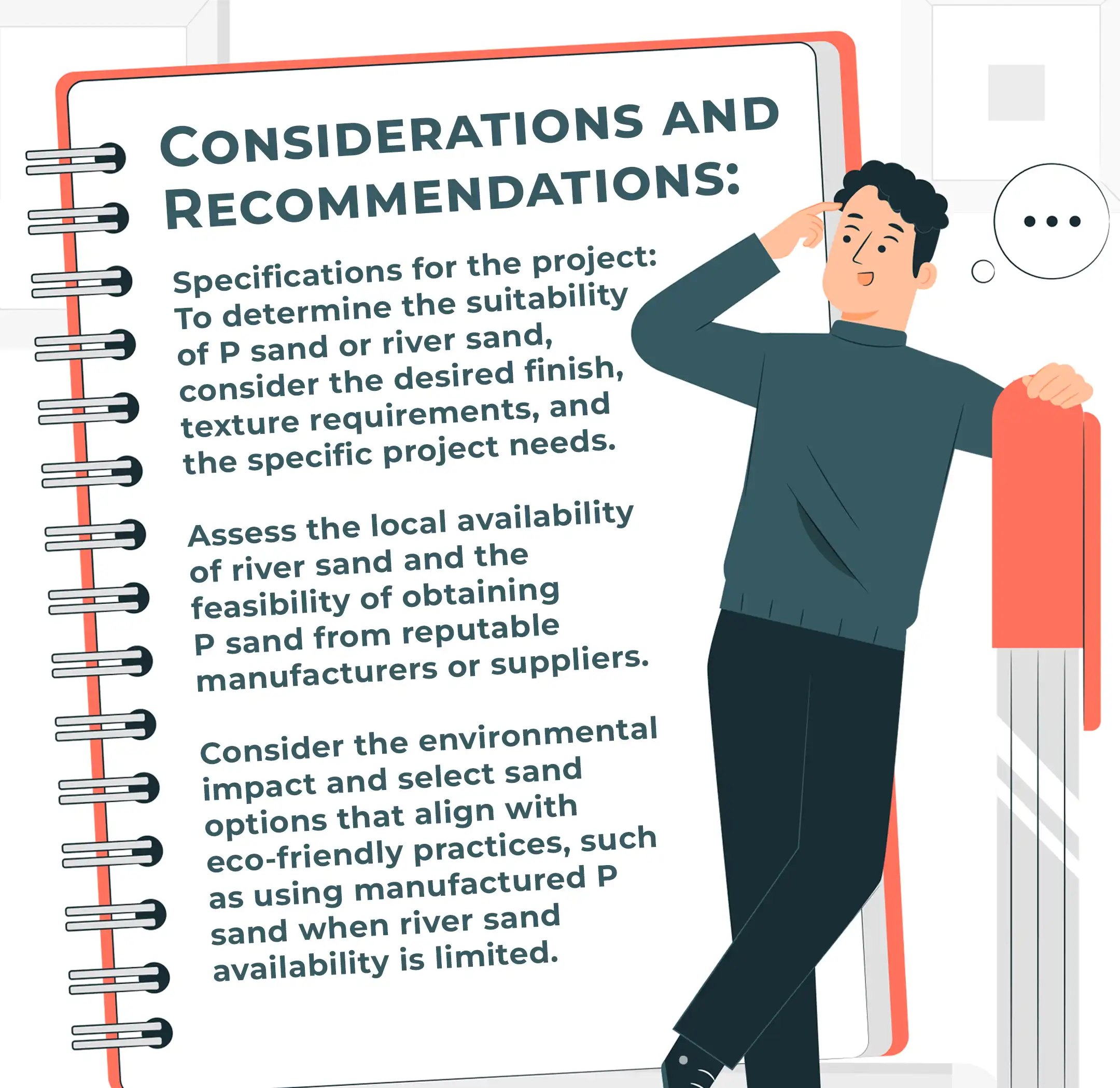
Understanding the difference between river sand and plastering sand is essential for construction professionals, especially when choosing materials for plastering applications. Each variety of sand has its own unique properties that make it suitable for specific features, and understanding these differences may help us improve the quality and durability of building/construction projects.
River Sand

Properties and Characteristics:
River sand is a naturally occurring sand substance that comes from riverbeds and banks. Natural erosion processes often result in smooth and spherical (rounded) grains. This sort of sand is known for its high workability and is commonly used in various construction projects.
River Sand is Commonly Used in:
Concrete Production: River sand is commonly used as a raw material in concrete mixes, which increases the finished product's strength and durability.
Masonary Work: It is suited for making mortar, which is required for the binding of bricks and stones.
General Building: River sand is used in landscaping and as a filler material in various buildings or construction projects.
Consideration:
While river sand is versatile, it may include impurities such as silt and clay, which might degrade plaster quality when used in construction. Additionally, the extraction of river sand may have environmental consequences, raising concerns and leading to restrictions in some locations.
Plastering Sand (P Sand)
Properties and Characteristics:
Plastering sand, offern reffered as P sand, is specifically processed to be used in plastering process. It is characterized by its fine, angular particles, which are important for achieving a smooth finish on walls and ceilings, as it is washed to remove silt, salt, and clay, ensuring a high-quality product.

Plastering Sand is Commonly Used in:
Internal and External Plastering: P Sand is the go-to choice for achieving smooth walls and ceilings, resulting in a high-quality appearance.
Rendering: Plastering sand is also used external application to offer a proactive layer that improves the look of structure.
Advantages of Using Plastering Sand:
Fine Texture: P sand's fine grain structure ensures a smooth application, making it suitable for both internal and external plastering projects.
Reduces Cracking and Shrinkage: Since the P sand is washed, it minimizes silt and clay content, which helps in preventing cracking and shrinkage during the drying process.
Strong Bonding Properties: The angular shape of the particles allows for better bonding in the plastering mortar, increasing the overall strength and longivity of the plastering surfaces.
Consistancy: The P sand is manufactured to gain particular grading standards, assuring particle size uniformity, which is crucial for maintaining constant plaster quality.
Difference Between Plastering Sand and River Sand
| Characteristic |
Plastering Sand |
River Sand |
| Source |
Processed and manufactured for specific use |
Naturally occurring from riverbeds and banks |
| Grain Size |
Very fine |
Coarse to medium |
| Texture |
Fine, angular grains |
Smooth, rounded grains |
| Impurities |
Washed to remove impurities |
It may contain silt, clay, and other impurities |
| Workability |
Smooth texture for easy application |
High workability |
| Bonding |
Smooth particles provide enhanced bonding |
Angular particles provide good bonding |
| Consistency |
Manufactured to meet specific grading standards |
Natural variations in particle size |
| Uses |
-
- Internal and external plastering
- Rendering
- Finishing work
|
-
- Concrete production
- Masonry work
- Landscaping
|
| Advantages |
-
- Smooth finish
- Reduced cracking and shrinkage
- Improved durability
|
-
- Readily available
- Cost-effective
|
| Limitations |
-
- Limited availability in some regions
- Higher cost compared to river sand
|
-
- Potential impurities
- Environmental impact of extraction
|
Availability and Sustainability:

P Sand:
Plastering sand can be manufactured, providing a consistent supply that is not completely dependent on natural sources such as riverbeds.
Sustainable alternative: Using P sand reduces reliance on river sand, which helps to preserve river ecosystems and reduces the environmental impact of sand mining.
River Sand:
River sand availability is becoming increasingly limited due to environmental concerns, regulations, and sand mining restrictions.
Dependence on natural resources: Extracting river sand from sensitive riverbeds can cause ecological damage, erosion, and habitat disruption.
Considerations and Recommendations:

Specifications for the project: To determine the suitability of P sand or river sand, consider the desired finish, texture requirements, and the specific project needs.
Assess the local availability of river sand and the feasibility of obtaining P sand from reputable manufacturers or suppliers.
Consider the environmental impact and select sand options that align with eco-friendly practices, such as using manufactured P sand when river sand availability is limited.
Conclusion:
When deciding between P sand and river sand for plastering, consider particle size, consistency, workability, availability, and environmental impact. While manufactured P sand provides fine particle size, uniformity, and consistent availability, river sand may still be viable if it meets project specifications and is easily accessible. Builders and contractors must evaluate the specific needs of their projects, considering both technical and environmental factors, to make an informed decision that ensures high-quality plastering results while promoting sustainability in the construction industry.
Frequently Asked Questions
Can P sand be used for plastering?
Yes, plastering sand (P sand) is specifically designed for and widely used in plastering applications. It's an excellent choice for smooth, visually appealing plastered surfaces on walls, ceilings, and other architectural elements. P sand has fine particle size, consistency, workability, and good bonding properties, making it ideal for achieving a high-quality finish and ensuring strong adhesion between the plaster and the substrate. As a result, P sand is widely used and recommended for plastering in construction projects.
Which sand is better for plastering?
Because of its fine particle size, consistency, and excellent workability, P sand (plastering sand) is generally considered better for plastering, resulting in a smooth and visually appealing finish. It has high adhesion properties, which ensures durability and reduces the risk of cracking or detachment. P sand is specifically selected and processed to meet plastering requirements, making it a preferred choice for achieving high-quality plastered surfaces compared to other sands.
Is plaster sand and river sand the same?
Plaster sand and river sand are not interchangeable. Plaster sand is a type of sand that has been specifically selected for plastering applications due to its fine particle size, workability, and strong bonding properties. Conversely, river sand is obtained from riverbeds and contains natural variations in particle size, making it less suitable for achieving a smooth plaster finish.